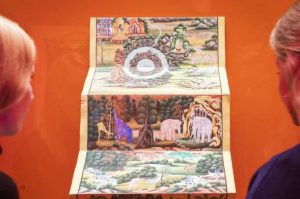Long buried in Cambodia’s heart, the mellowing melody of Theravada Buddhist poetry remained a hidden treasure, unheard by many Anglophone ears. That is until author and Buddhist scholar Trent Walker, captivated by the haunting verses of the Dhamma songs, translated a unique collection that spans centuries—each one a whispered secret from the country’s ancient soul.
Shambhala Publications introduced Walker’s Until Nirvana’s Time: Buddhist Songs from Cambodia in December 2022, effectively filling a historical void in English translations of Theravada Buddhist verse.
Walker has remedied this absence by translating 45 Dhamma songs dating to between 1620 and 1866, and most of which are authored anonymously. These ancient voices from the temple-strewn sacred hill of Oudong, the former royal Khmer capital, sing of sorrowful laments and colorful tales—from the life of the Buddha to familial gratitude (these ancient voices also wisely reminded me to be grateful to my own family and forgive my young self); from reflections on the fleeting nature of life, to yearnings for nibbana; and much more are held in these delicate cradling arms of wisdom, through the virtues of vowels and consonants, idioms and aphorisms meditated over so many years ago.

Cambodia, and the Khmer Empire that flourished in Southeast Asia from the 9th–15th centuries, gave birth to a rich cultural and spiritual heritage that is deeply intertwined with Theravada Buddhism. The poems, a testament to the universal human experience, transcend the bifurcated image of Cambodia, moving beyond ancient splendors and modern horrors. These are offerings from a culture rich in spirituality, literature, and art, in which the Khmer language dances in celebration of the Dhamma. The poetry that emanates from this tradition is so often an eloquent expression of spiritual insights, meditation practices, and the profound teachings of the Buddha.
In line with the Cambodian Dhamma song tradition, there is an emphasis on the slow pacing, complex melodies, and ritual contexts of these verses. The translations aim to preserve the clarity and vitality of the original Khmer texts, maintaining their syllabic and linear structures while providing insights into doctrinal, performative, historical, and aesthetic dimensions, honoring the profound connection between breath, music, and meaning. No mean feat. Poetry translation is as challenging as translation can be—let alone when the texts also span hundreds of years of nuances and layers that already demand a deep reflection in their original language and contexts. Translating Cambodian Buddhist poems poses additional challenges because of to their intricate meters, unusually elaborate melodies, and complex rhymes.
More than 60 different melodies, each tied to specific meters, are employed in the performance of these Dhamma songs, which evoke emotional responses, either stirring (samvega) or calming (pasada), shaping the connection between words and emotions. Walker maintains a delicate translation balance, considering musical and affective dimensions.
The translation approaches include rhymed, unrhymed, extended, and free methods. Thirty-three translations maintain Khmer syllabic structures for English performance, while 12 employ extended or free methods. Rhyme patterns, dense in Khmer, are challenging to replicate in English, but these translations aim to preserve the elegance and compressive nature of Cambodian poetry. These four translation methods offer a range of perspectives on the source texts, recognizing the inherent compromises inherent in translating ancient languages, cultures, and spiritual traditions. My inner information-hungry nerd found particular enjoyment in the book’s relatively concise part two, titled “The Essays.” This section, as implied, provides a quick, yet insightful, exploration of topics such as the evolution of Cambodian Buddhism (1850–1950).

Yet, with all the information Walker offers us, the pages of poetry themselves remain unencumbered as he breaks down and explores the different aspects of Cambodian metrical forms, the relationship between meter and melody, and the impact of different melodies on emotions. In part three, at the back of the book, Walker discusses the represented meters and their historical development, emphasizing the stanza as a fundamental unit in Khmer poetry. He details the unique histories of the 45 Cambodian Dhamma songs, tracing their evolution through time and through the influences of scribes and chanting masters. Each song’s essential ingredients, such as title, meter, and performance style, are provided, along with details on sources and interpretative notes revealing hidden meanings and connections to Pali sources. Walker gently encourages us to explore the rich narratives embedded in the songs with the help of these insightful notes.
My romantic, philosophical self adores the wings upon which we can fly through time and soar through the thoughts of ancient souls shared through these poems. Yet my inner information-hungry nerd particularly enjoyed the relatively brief part two, “The Essays,” which, as I have implied, offers us fly-by erudition in the evolution of Cambodian Buddhism, colonial influences, textual shifts, and the impact of modernization and the interplay between traditionalism and modernism; the preference for buddhahood over arahantship; future aspirations and the veneration of past and future buddhas; meditation practices; esoteric systems; heart syllables (particularly in connection to the 33 parts of the body); and more. While not integral to the enjoyment of the poems themselves, it is a valuable treatise that many Khmer neophytes, Buddhists, and history buffs, will find enriching.
Walker has done a beautiful job in helping these poems transport us into romantic realms and ways of being. We readers can traverse a landscape of ancient wisdom. We can imagine or, better still, sing and energetically join those of an ever-present past, where the syllables linger like incense carried on the wings of breath and melody. These verses, a bridge across time, invite contemplation beneath the moonlit canopy of night rituals, echoing healing, mourning, dedication, and consecration.
See more
Until Nirvana’s Time: Buddhist Songs from Cambodia (Shambhala Publications)
Trent Walker
Related features from BDG
Book Review: Red Tara: The Female Buddha of Power and Magnetism
Book Review: The Power of Mind: A Tibetan Monk’s Guide to Finding Freedom in Every Challenge
Book Review: The Tibetan Yogas of Dream and Sleep













Thanks for the informing us about these valuable buddhist news. Thanks again.